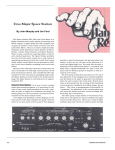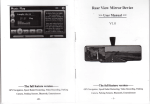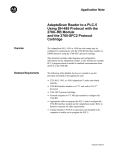Download SQN-4S Series IV User`s Handbook
Transcript
SQN-4S Series IV User's Handbook Contents 11 6 10 19 17 18 5 1 8 4 AUDIO LEVEL METERS AUXILIARY MONITOR INPUTS BASS CUTS CONNECTOR LIST CONNECTOR WIRING - 12 WAY CONNECTOR WIRING - 10 WAY CALIBRATION OF THE RECORDER INTRODUCTION LINE INPUTS LINE-UP TONE 9 7 14 13 12 3 2 16 15 .. MASTER GAIN CONTROL MICROPHONES MIXING AND MATRIXING MONITORING HEADPHONES OUTPUT LIMITERS OUTPUTS POWERING THE MIXER SERVICE SLATING MICROPHONE TECHNICAL SPECIFICATION 1. INTRODUCTION The basic information necessary to allow a recording engineer to operate the SQN-4S audio mixer is permanently displayed on its baseplate and cannot be lost. The aim of these instructions is to explain the mixer's facilities and functions in more detail to those who are already familiar with the microphones and techniques that are employed by professional sound recordists. Users of the earlier SQN mixers will naturally want to know in what respects the SERIES IV differs from the previous models. The new mixer again has four input channels and two main outputs. In addition, access has been provided to the Post-Fader outputs of two of the channels so that it is possible to feed four fader-controlled (unbalanced) outputs to an external recorder. Pre-fade listening to all of the input channels is now included, as is a 'slating' microphone. The power wiring now allows the fuse-protected feeding of external power to other equipment, controlled by the mixer’s Power Selector switch. MODAL OPERATION. The SQN-4S SERIES IV offers a logical extension of the facilities available on the previous SQN-4S series of mixers and, in order to simplify operation of the extended facilities, the ganging and matrixing controls are organised somewhat differently. The overall concept is one of "MODAL OPERATION" in which the channel pair is set up to operate in one of three modes, selected by the [GANG] switch: 1. TWIN MONO 2. STEREO 3. MID-SIDE (with matrixing to or from AB stereo) The effects on the operation of the other controls of selecting these three modes are described in section 14 below. This method of operation may seem a little complicated at first, simply because it is different, but it will soon be found that the ability to have operational only those controls required for a particular mode is very convenient. 2. POWERING THE MIXER 1. INTERNAL BATTERY. The SQN-4S should be powered by Mallory Type MN 1500 or other manufacturer's equivalent AA size alkaline cells. The quiescent consumption of the mixer is approximately 160mA at 12V and with dynamic microphones about 10 hours of continuous operation can be expected from fresh cells. Rechargeable nickel cadmium cells may be employed for maximum economy, but types fitted with solder tags may be found mechanically unsuitable. If all cells are good they may be recharged in series using an external charger unit, which can be connected to the 4-way connector [DC] next to the battery compartment door. The endurance of nickel cadmium cells will be about half that of alkaline cells. For maximum life, lithium cells giving 3 volts per cell can be used, since the power supply will accept inputs up to 24 volts. The use of ordinary ‘dry cell’ carbon zinc cells, which may leak and cause extensive damage, is definitely not recommended. In any case, when used in the SQN-4S they give a small fraction (about one fifth) of the life of alkaline cells, so they are a false economy. If such cells are fitted in an emergency, it is most important that they be removed immediately after use. Similarly, any type of battery should be removed if the mixer is to be stored for any length of time or transported, particularly by air. To fit the cells, slide the battery door catch on the right side of the mixer towards the front panel to release the door and insert two rows of four cells in series, so that the lower tube has the positive poles facing the door and the upper tube the negative poles, as is indicated on the door itself. If the cells are inserted with incorrect polarity the mixer will not function; an internal protection circuit prevents damage to the mixer power supply. When operating from the internal battery supply, switch the power selector switch next to the battery door down to the [BAT] position to power the mixer. A green LED between the meters lights up to indicate that the mixer is switched on. The right channel meter doubles as a voltmeter for the power supply when the adjacent [BATT] push button switch is depressed. The mixer is guaranteed to work down to a battery voltage of 6 volts, so that as long as the battery meter reads on scale, performance will be to specification. If the voltage is allowed to fall lower (to about 4.8 V) then eventually the internal power rails will fall. This will affect the headroom of the output and monitor amplifiers and the setting of the Line-Up tone; ultimately the performance of the whole mixer will be degraded. It is worth noting that as the battery voltage falls, the current drawn by the power supply will increase to maintain the required power input. The battery voltage is, therefore, likely to fall quite quickly as the cells become exhausted 2. EXTERNAL POWER SOURCE. A direct current supply in the range 6 to 24 volts can be connected to the 4-Way connector [DC] next to the battery door. In order not to restrict the usable types of powered microphones, the power supply must be capable of delivering 2.5W while maintaining an output voltage in the required range. The mixer’s power input terminals float with respect to the SQN-4S ground, so a supply which does not share a ground with the SQN-4S may be used, e.g. a camera battery. The power supply input of the SQN-4S is protected against connection of an external voltage with reversed polarity. If it is desired to power the SQN-4S from an external DC supply at higher voltage than 24V, reference should be made to the manufacturers To power the SQN-4S from an external supply the Power Selector Switch by the battery door must be switched up to the [EXT] position. 3. EXTERNAL POWER FEED. When the mixer is being powered from an external supply, that supply is also made available at the 4-WAY connector [PT] on the main connector panel. This is intended to supply power to other devices with which the mixer may be working. This power feed is short-circuit protected by self resetting thermal fuses and is switched on by the mixer’s power switch in either the [BAT] or [EXT] position. Many users of these mixers prefer to power them and several extra pieces of equipment from an NP-1 camera battery, the whole being kept together in a special carrying bag. An extremely long endurance can be expected from the NP-1 but it is necessary to be careful that the battery is not allowed to discharge below the manufacturer’s recommended minimum of 10V (use the [BATT] test); the mixer will continue to work but the battery will have its life reduced. 3. OUTPUTS The mixer is provided with two balanced line driver amplifiers of substantial capacity. The output transformers of these amplifiers also carry windings providing isolated, nominally ‘Mic Level’ outputs. Additionally, unbalanced feeds of the two main outputs and the ‘Post Fader’ outputs of input channels 3 and 4 are available at 10dB below the main line driver level with 200 Ohms source resistance. All of these signals are made available on the connectors at the end of the mixer. The connection list for the multi-way connectors is given in section 18, reproduced from the mixer base label. The connections for the two XLR-3M connectors are to the usual convention (1 GND, 2 Live, 3 Return). Two switches on the base of the mixer allow the feed to the [MAIN] connector [A] or the XLR connectors to be taken from the Line Level or Mic. Level outputs. A third switch [Zout] allows the output resistance of the Line Level feed to the XLR connectors to be increased up to nominally 200 Ohms. This will allow the mixer to operate (with the limiters on) into an arbitrarily low resistance load. This facility is provided for compatibility with earlier versions of the SQN-4S. 4. LINE-UP TONE A calibration Tone of 1.05kHz is available and may be injected into both output channels by operating the 3-way front panel [TONE] switch. Switching to the first position from the left, [M] gives continuous tone on both channels and to the [S] position gives an EBU coded tone signal (the left channel interrupted for 250ms every 3s) to indicate that the recording which follows is true stereophony. The tone mutes and replaces the main audio. The calibration level for a given meter reading is indicated on the baseplate of the mixer and, unless specially requested, it will be at the Nominal Line Level (see the next section). 5. CALIBRATION OF THE RECORDER The recorders that are used with the SQN-4S are almost invariably fitted with some form of input gain control. In these circumstances the absolute calibration levels of both the mixer and the recorder become irrelevant: what must be considered are the relative calibration points Nominal Line Level (0VU) and Nominal Peak Level on the meters of both instruments and how they are to be related. The basic calibration used at SQN is to place the Nominal Line Level at PPM4, ‘TEST’ or 0VU and then to treat the Nominal Peak Level as being 8dB above this, in the case of the PPM or VU meter or 6dB above in the case of the Nordic type of meter. The limiter is then set to come into operation on a steady tone at 1dB below the Nominal Peak Level. This ensures that the mixer output will not exceed the Nominal Peak Level when measured using a Peak Programme Meter. The Line-Up tone is then usually set to the Nominal Line Level. In any case, the calibration points, including the limiter setting are shown on the individual mixer baseplate. When interfacing to an analogue recorder with its typical slow overload characteristic, what is required is to place the mixer’s Nominal Peak Level at the correct point which will ensure that the recorder will not be overloaded by a limited transient output from the mixer. Most of the ENG recorders use VU meters, with which the Peak Level is off scale. The reference point we use, therefore, is the Nominal Line Level - the level to which the mixer’s Line-Up tone is set. Experience has shown that most of the usual ENG recorders are calibrated so that their Nominal Line Level or 0VU is only 6dB below the level at which distortion is beginning to increase. Accordingly, it has become the practice to adjust the recorder’s gain control to place the mixer’s Line-Up tone at ™2dB on the recorder’s VU meter. Some recordists prefer to go further and leave themselves a little more headroom on the recorder by placing the line up tone at ™4dB on the recorder’s meter. Interfacing to a digital recorder with its much more sudden and unforgiving overload characteristic requires that the Nominal Peak Level of the mixer be placed below the peak level of the recorder. This is because the limiting, as carried out on the mixer assumes that the following recorder is tolerant of some degree of overload for periods up to 1ms, hence the emphasis on the measurement using a Peak Programme Meter in the paragraph above. Fortunately, digital recorders, because of their clipping characteristics, are almost always fitted with fast peak meters, reading on a sample by sample basis. It is easy to set the matching between the mixer and the recorder experimentally using limited transients such as sharp handclaps. Typically, the Line-Up tone should be placed 12dB below the allowed peak level. 6. AUXILIARY MONITOR INPUTS The SQN-4S Series IV features twin auxiliary inputs on its 12-way [MAIN] connector [A] which are intended to accept a return signal from whatever recorder the mixer is feeding. The input sensitivity is set by adjusting the screwdriver-operated potentiometer marked [MONITOR SENSITIVITY ADJUST] in the base of the mixer and can usually be fixed with sufficient accuracy by ear by operating the [MIXER AUX] switch situated below the Master fader to and fro with the line-up tone on and adjusting for parity of loudness. This feature allows before/after comparison of off-tape monitoring, or, when used with a recorder that lacks off tape monitoring, it can be used as a check that mixer outputs are at least reaching the recording inputs. The [MIXER AUX] switch affects only the headphone signals. Many ENG recorders feature an ‘Earphone Monitor’ output on a 3.5mm jack, intended for the cameraman’s use. This often carries audio warning of tape end or other errors, but because it is fed from the recording head the practice has grown of using it for audio confidence monitoring even though it is usually Dolby encoded, contaminated by time-code noise, unbalanced and at very low level (typically -16dBu). Cable looms incorporating quad stereo leads in a single flexible cable of only 7mm diameter have been developed at SQN for use in interfacing such recorders with the 12-way [MAIN] socket [A] of the mixer. They are available in straight or coiled formats. 7. MICROPHONES The four identical XLR-3F microphone input connectors are wired to conform with the IEC standard (Pin 1 ground, Pin 2 in phase and positive for T-powering). The SQN-4S is designed to accommodate all professional microphones and assumes a source impedance for dynamic microphones in the range 150-600 Ohms. Condenser microphones, of course, will present source impedances much lower than this but because of the absence of input transformers in the mixer, the frequency response will be unaffected. It is outside the scope of this manual to describe in any detail the various types of microphone which may be employed, but the type will determine the settings of switches set into the baseplate of the mixer. While the SQN-4S has sufficient current capacity to supply any make of condenser microphone, the use of microphones which have a particularly large current drain with battery-powered equipment will need careful consideration. Some marked improvement in performance or special tonal characteristic should be required as compensation for the reduced battery life. There are some powered microphones that are switchable or automatically switch between 48V and 12V phantom powering. These will typically have their power consumption reduced by a half in the 12V phantom mode with unimpaired performance. The primary purpose of the Microphone Attenuators [ATTEN] is to provide a rough level match between the input signals from microphones of varying sensitivities so as to allow comfortable handling of the gain controls. The ‘attenuators’ are, in fact, switched gain controls so that there is no need to fear a worsening of noise performance from their use. It is, of course, not good practice to rely on attenuators (or gain controls) when using sensitive condenser microphones close to loud sounds, such as motor sports or pop music, since such signals may well overload the microphone’s own first stage. In those conditions the ambient noise level can even prevent such a disaster being detected on your headphones. The use of dynamic microphones may be more appropriate in these cases. Rotary faders were selected for the SQN-4S because of their inherently better environmental sealing and because they provide more mechanical movement in a small space than can a slider type. The specially designed control knobs incorporate some of the advantages of the slider in that they can be pushed from the side and their position is unequivocally seen and felt. Turning over a considerable arc is achieved with the tip of the finger or thumb resting on the point of the arrow design. 8. LINE INPUTS All four of the microphone inputs may be individually switched for use as balanced line inputs. This is achieved simply by switching a fixed 50dB attenuator in front of the microphone amplifier. The attenuator and fader controls operate as before. A pair of unbalanced inputs, feeding directly into the left and right mixing busses is also available on the [SUBSIDIARY I/O] connector, [B]. These inputs are primarily intended for cascading two mixers. 9. MASTER GAIN CONTROL The Master fader controls the gain of the two output channels simultaneously. There is a reserve of gain of 6dB above the 0dB calibration point (which is located by a mechanical detent), so that this control can be used to raise the overall level of a mix as well as to fade in and out. 10. BASS CUTS A Bass Cut switch for each microphone channel is situated next to its fader allowing for bass attenuation of the signal with cutoff frequency and slope that depend on the setting as shown in the accompanying graph, reproduced from the base label. These are employed for a variety of purposes, such as reduction of ‘boominess’ in hard or ‘live’ acoustic locations, or from deep voices, as well as reducing extraneous traffic rumble, ‘mains hum’ from electrical appliances and so on. Perhaps the most common use for bass cuts is to assist in the reduction of wind noise outdoors, but a suitable windgag on the microphone will also be essential. 11. AUDIO LEVEL METERS The basic type of metering employed on the SQN-4S is the Peak Programme Meter (PPM). This was chosen as providing the maximum information about the relationship between the signal level and the overload point of the recorder. Admittedly, peak meters do not necessarily give a true representation of the loudness of the signal and some recordists prefer the VU type of meter which we can also provide. The meters can only give a useful indication of the recording level when the combination of mixer and recorder has been calibrated. Each meter is permanently lit for operation in very low light, without any current drain on the mixer. For those unfamiliar with the BSI (BBC style) PPM scale, the intervals between scale graduations represent a 4dB difference, so that with the nominal Line Level (0dBu) represented by 4, the nominal Peak Output Level of the mixer (+8dBu) occurs at 6 on the scale. This 'Nominal Peak' is a simplification of the arguments, since in practice the BBC has adopted various preferred peak levels for different sound sources and even individual musical instruments. Other PPM scales have not followed the BBC design and are all expressed in decibels, which makes them more readily intelligible. They also usually feature a TEST arrow at 0dBu (0.775V) for calibration purposes. The 'nominal peak' level referred to above tends to be seen as +6dB where the scale is calibrated in 3dB steps (e.g. the 'Nordic Norm' pattern adopted by the Scandinavian Broadcasting Consortium) or +8dB where calibration is in 4dB increments (e.g. the SMPTE 'preferred' scale published in 1989 where this peak level is scaled as '0'). VU meters also vary in their calibration. The original VU measured zero at zero dBm in a 600 Ohm system. Modern practice, based originally on the improved high level performance of analogue recording tape, is to place zero VU at +4dBm. Either calibration can be provided and will be noted on the mixer baseplate. 12. OUTPUT LIMITERS Location recording frequently puts the recording engineer in a situation in which he or she has no control over the ambient sound level. Accordingly, the SQN-4S has been provided with a pair of output peak limiters that may be confidently employed at all times. Coming into operation just below peak level, they comfortably accommodate overloads of +17dB with an attack time of half a millisecond and a release time of 100ms. Peak limiting is an extremely non-linear process that relies on the masking characteristics of the ear to render the effect essentially inaudible when executed properly and used in moderate amounts. It is bad practice to make a habit of 'riding' the limiters: the LEDs should only light on the occasional unexpected peak if the levels are correctly set. Allowing the limiters to be operated by low frequency or sub-audio rumbles will cause modulation of the more audible midrange and high frequency audio. In the worst case this may manifest itself as apparently random audible clicks. The bass cuts should be used to remove dominant low frequency signals so that the limiters are operated only by signals in the wanted audible range. The Limiters are actuated by a switch [LIM] next to the meters and in the [M]ono position each output channel is separately limited, with actual limiting being indicated by an LED for each channel, placed between the meters. With stereo recording, limiting can introduce a further problem since, if only one channel of a stereo pair is subjected to limiting, the effect is to shift the stereo image. The [LIM] switch, therefore, has a third [S]tereo position in which the degree of limiting is governed by the higher of the two output channel levels. This setting should be used when the mixer output is stereo, of either type AB or MS. 13. MONITORING HEADPHONES The quarter inch jack [PH] of the SQN-4S will accept any standard stereo plug. Headphones of any impedance may be employed although impedances of around 200 Ohms will make best use of battery power. For location work, it is advisable to employ headphones with good ear sealing even though they can be uncomfortable when worn for long periods of time. Increasing the headphone level to drown the directly audible sound in noisy situations could prove fatiguing or even damaging to the hearing in the long term, particularly if the limiters are not used. The control knob next to the headphone jack allows the headphone output level to be adjusted - down to zero if desired. A rotary [PHONES] switch on the front panel allows the operator to select various sources for the monitored signals, including the output of an MS matrix which will allow an MS signal being output from the mixer to be monitored as the equivalent AB signal. This switch has the following functions. • • • • • • S Stereo L Left Channel R Right Channel L+R Left plus Right (MS stereo equivalent Left or Phase Check) L-R Left minus Right (MS stereo equivalent Right) MS MS Matrix (MS stereo equivalent) Pre-Fade Listen on each Channel: • • • • PF 1 PF 2 PF 3 PF 4. 14. MIXING & MATRIXING CONTROLS The SQN-4S SERIES IV mixer is intended to work in various modes and particularly to accommodate the use of Mid-Side microphones and Mid-Side recording. The four input channels are designated as two pairs in which the individual channels are referred to as the first and second channels thus: CH1 & 2: CH1 is the first channel and CH2 the second channel CH3 & 4: CH3 is the first channel and CH4 the second channel Each channel pair has the switch controls [GANG], [MAT] and [PHASE], and the CH3, CH4 pair has the additional control [PAN] These controls allow the following modes of operation on both channel pairs: 1. TWIN MONO with the [GANG] switch at [0]. The two faders operate independently. The pan switches at the end of the mixer can direct the signals to either of the two mixing busses or, in their central [PAN] position, to the panpots which will allow AB stereo panning between the two busses (but see the front panel [PAN] switch below). The [MAT] switch is inoperative 2. STEREO with the [GANG] switch at [S]. The input and output from the pair are treated as an AB stereo signal. The gains of both channels are controlled by the first channel fader and the first channel panpot acts as a balance control. The [MAT] switch is inoperative. The second channel fader, the pan switches and the second channel panpot are inoperative. 3. MID-SIDE with the [GANG] switch at [MS]. o With the [MAT] switch to the left. The input and output from the pair are treated as an MS stereo signal. The gains of both channels are controlled by the first channel fader. The second channel fader acts as an MS width control and should be fully clockwise for full width. The pan switches and panpots at the side of the mixer are inoperative. o With the [MAT] switch to the right (arrow). The input from the pair is treated as an MS stereo signal which is then [MAT]rixed into AB stereo for output. The gains of both channels are controlled by the first channel fader. The second channel fader acts as an MS width control and should be fully clockwise for full width. The pan switches and panpots at the side of the mixer are inoperative. The [PHASE] switch acts on the second channel of the pair, independently of the settings of the other switches. When it is moved to the right (arrow), it inverts the phase of the signal. This has the incidental effect of interchanging left and right in an MS encoded signal. The second channel pair, CH3 & CH4, has an extra front panel switch labelled [PAN], not to be confused with the side mounted pan switches, whose functioning it alters. This has a dual function and three positions which work as follows: 1. STEREO PANNING with the [PAN] switch at [S]. In the twin mono mode, when panning is available, the pan switches at the side of the mixer can direct the signals to either of the two mixing busses or to the panpots which will allow AB stereo panning between the two busses. 2. MID-SIDE PANNING with the [PAN] switch at [MS]. In the twin mono mode, when panning is available, the pan switches at the end of the mixer can direct the signals to either of the two mixing busses or to the panpots. In this mode, when the pan switches at the side of the mixer are in the [PAN] position, however, the signal emerging from the mixer is assumed to be Mid-Side Stereo and the panning will be into the equivalent AB stereo image. The effect of this can be monitored using the headphone MS matrix by placing the [PHONES] switch in the [MS] position. 3. SIGNAL DISCONNECT with the [PAN] switch at [D]. The CH3 & CH4 signals are removed from the mixing busses. They remain available on the two Post-Fader outputs. If this feature is not required, and it will probably not be by most recordists, it can be disabled by removing a programming link which is located under the top lid, just behind the [PAN] switch on the system board. Without this link, position [D] behaves as position [S] so that conventional AB panning can be achieved simply by placing the [PAN] switch to the left. Mixers from serial No. 50118 do not have this link in place when dispatched. 15. SLATING MICROPHONE A microphone is mounted behind the front panel at the right hand end of the mixer. This is brought into use by pressing a button at the front of the pan switch recess on the side panel and is intended for recording identification announcements and slating marks on the output channels. The output of the microphone is levelled by a 2:1 compressor and overrides the main audio, appearing on the mixer outputs and in the monitoring system. If the monitoring mode is set to [AUX] at the time the button is pressed, it automatically reverts to the internal or [MXR] setting. This is so that the recordist, if working with a recorder equipped with off-tape monitoring will not have to talk over a delayed version of the announcement. The use of the compressor means that a usable recording can be made by speaking in a normal voice over a range of 1.5m to 250mm from the mixer, depending upon the ambient noise level. 16. SERVICE The SQN-4S is guaranteed to be free from defects in workmanship and materials for a period of 12 months from delivery, before which it has undergone lengthy, searching tests. If any problem should be encountered during or after this warranty period, the owner is urged to return the mixer to the factory where it will receive prompt attention. The circuit boards are of multi-layer construction with tracking on an inner layer and carry a mixture of through-hole and surface mount components. Although the boards are reasonably robust, it is worth pointing out that inexpert removal of a through-hole component could damage the connection to one of the inner layer tracks. This would be impossible to repair and would have to be bypassed in a most untidy manner. It could also lead to a fault which would be difficult to diagnose. Similarly, work on surface mount components is best left to those with the correct tools and experience. 18. SCREW-LATCHING CONNECTOR WIRING (10W) Screw-latching connectors are now provided only to special order. All input and output connectors are now normally either XLR latching or Push-Pull latching types. The connection list below applies to mixers fitted with the the screw-latching version of the MAIN I/O connector. This optional fitting is intended to provide direct compatibility with cables made for earlier models. . 19. CONNECTOR LIST The following is a list of the manufacturers part numbers for the connectors to mate with those on the mixer MIXER CONNECTOR MAIN I/O [A] (STANDARD) MAIN I/O [A] (SCREW) SUBSIDIARY I/O [B] POWER INPUT [DC] POWER THROUGH [PT] MATING CONNECTOR PRC05P12M RM15PD10P HR10-10P12P HR10A7P4P HR10A7P4P MANUFACTURER Tajimi Hirose Hirose Hirose Hirose

























